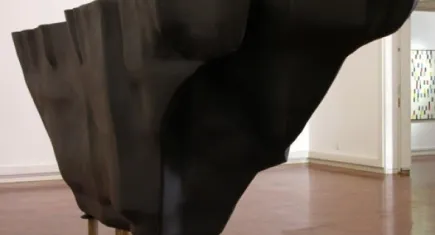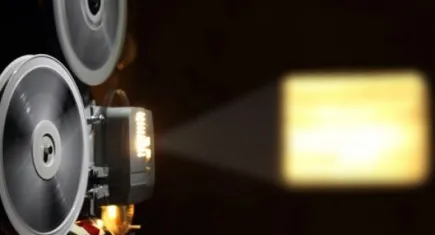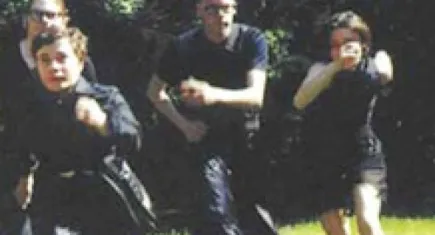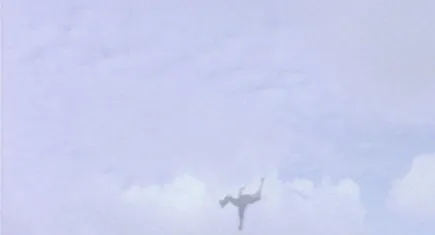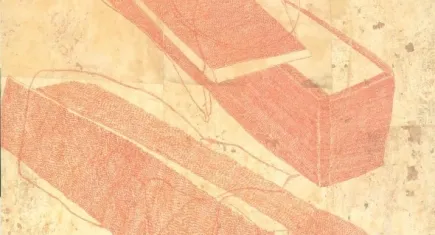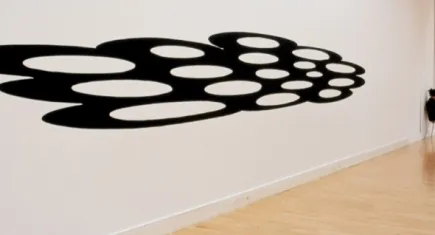Mead Gallery Exhibitions 2003
Adam Dant: The People Who Live on the Plank
In association with The Drawing Room, London
Sat 27 Sep – Sat 6 Dec 2003
Adam Dant is a young British artist, living and working in London. This is his first UK touring exhibition which has been organised by The Drawing Room, a new gallery in London which focuses on aspects of contemporary drawing practice.
Looking round the Mead Gallery, these drawings resemble large comic books. Every day for five years, Adam Dant wrote, drew and published Donald Parsnips’ Journal, a postcard sized comic book that he distributed free to passers-by, wherever he happened to be. It combined odd cartoons with slogans like “Beware, wild horses will try and keep you away from things you don’t want to go to” and lists like “Why you shouldn’t paint” : 3. It involves the use of paint and 4. People will only buy the results. This led to a regular column in the Sunday Independent where the minute idiosyncracies of everyday life take on immense signficance.
Looking round the Mead Gallery you will see sequences of smaller drawings in which the roundels gradually increase in size. The first two concentrate on a series of events located in Dant’s neighbourhood in East London. The Romance of the Square and The Cult of the Corner and The People Who Live on The Plank present series of events, small in themselves, but all with catastrophic dimensions. Where We Go When We Die looks at the possibilities for an after-life for members of different religious groups. The two big drawings, Wall Street English and Five Economic Systems again propose a series of domino-linked events, small in themselves, that build into chains of events that evoke a sense of catastrophe. Dant has described his work as akin to soap-operas and there is certainly an equivalent sense of the way that tiny events, like not telling someone the truth, can build into big dramatic storylines.
The narrative constructions are immediately apparent through the formal structure of these intricate drawings. However the narrative structure is actually complicated by its matrix form. The viewer determines the course of the narrative and they nod backwards and forwards and around the work; pursuing a non-linear course in an ostensibly linear work.
Each roundel is also rich in narrative detail. Dant has tried to make them as dense as possible without resorting to language. Facial expressions, actions and situations are the vehicles for the stories. The drawings all have the same sense of depth. There are no long shots, no sense of landscape. In this, they are theatrical rather than filmic although it could be argued that the same focus on character and event is found in the television soaps where the wider urban area is only seen in the opening sequence of Coronation Street or the city of London is viewed, as if from space, again only in the opening sequence of East Enders.
Adam Dant’s work has been described as Hogarthian or Swiftian in its use of satire. However, here there is no sense of condemnation. He has taken the extremes of daily life as presented in our mass culture and gently re-presents them to us in a way that questions our acceptance of televisual realities as much as it makes us laugh.
This exhibition was funded by The Moose Foundation for the Arts and The Elephant Trust.
Infallible: In Search of the Real George Eliot
Sat 27 Sep – Fri 5 Dec 2003
Linda Aloysius, Lisa Appiganesi, Artlab: Charlotte Cullinan + Jeanine Richards, Jordan Baseman, Nicholas Blincoe, Jon Cairns, Julia Darling, L’Ecole de Burrows et de Bob Smith, Volker Eichelmann/Roland Rust, Mark Fairnington, Paul Flannery, Maureen Freely, Tony Halliday, Nicky Hirst, Brigitte Jurack, Ian Kiaer, Sara MacKillop, Mary Madden, Duncan McLaren, Fabian Peake, Joao Penalva, Adrian Rifkin, Rommi Smith, Rob Stone, Annika Sundvik, Eve Sussman, Roxy Walsh, Ralph Wolf.
This exhibition was an artist-led project bringing together the work of established artists, writers and recent graduates in real and virtual space. It took its title from the notion of Papal Infallibility – the idea that the voice of God on Earth cannot be wrong, which was decreed as a doctrine during the First Vatican Council (1870 – 1917). It deployed and investigated the narratives of authority and belief through fiction, ventriloquism and disguise, embracing realist painting and the comic excesses of fancy dress.
On General Release: Artists and Film in Britain 1968-1972
A Touring Exhibition from the Norwich Gallery, Norwich School of Art
31 May – 27 June 2003
Andrew Logan, Annabel Nicholson, Berwick Street Film Collective, Bruce Lacey, Bruce McLean, Carolee Schneemann, Chris Welsby, Dan Graham, Darcy Lange, David Askevold, David Crosswaite, David Dye, David Hall, David Lamelas, David Tremlett, Derek Jarman, Esther Ronay, Fred Drummond, Gill Eatherley, Guy Sherwin, ian Breakwell, Jack Smith, Jeff Keen, John Baldessari, John Black, John du Cane, John Hilliard, John Latham, Kenneth Anger, Kurt Kren, Lawrence Wieiner, Liz Rohodes, Malcolm Le Grice, March Chaimowica, Marcel Broodthaers, Margaret Tait, Mark Boyle, Mary Kelly, Michael Snow, Mike Dunford, Mike Leggett, Paul Botham, Peter Gidal, Peter Watkins, Peter Whitehead, Pip Beneviste, Ray Barrie, Roger Ackling, Roger Hammond, Sally Potter, Steve Dwoskin, Storm de Hirsch, William Raban
curated by David Curtis and Lynda Morris, assisted by Matthew Noel-Tod
On General Release explores the origins of avant-garde film in Britain. It presents a rare opportunity to see a wide range of avant-garde films made, or shown, by artists and filmmakers during the crucial and influential years 1968-1972. It will include the art school film experiments which laid the groundwork for the explosion of artists’ films during the 1970s, as well as work by international filmmakers and artists whose work shaped the idea of avant-garde film at the time. Siting these programmes within galleries, rather than cinemas, reflects the critique by artist filmmakers of the use of cinemas in the period 1968 to 1972. Filmmakers sought to position their identity as close to that of visual artists. Meanwhile, artists who made film had the expectation of showing it in galleries.
The exhibition will be comprised of four thematic programmes: Performance, Art Schools, The Gallery, and Documentary. The programmes bring together artists and filmmakers from Fluxus, Structuralist and Conceptual practices, reflecting the creative vitality and diversity of the period. On General Release represents the full spectrum of experimentation, from classics such as Kenneth Anger’s Invocation of My Demon Brother and Carolee Schneeman’s In Quest of Meat Joy to Lutz Becher’s early experimentation with electronic imagery, and David Crosswaite’s virtuoso technical experiments.
Curators
David Curtis has organised the British Artists Film and Video Study Collection at Central St Martins. He was previously film officer at the Arts Council of England. David Curtis’ research has shown that in 1960 to 64 there were as few as five artist filmmakers in Britain, in the course of 1965 five more appeared. By 1975 there were 140 Independent filmmakers listed. David Curtis programmed the Arts Lab Cinema in Drury Lane 1967 to 1968 and Robert Street near Warren Street 1969 to 1971.
Lynda Morris worked at the ICA from 1969 to 1971 and then for Nigel Greenwood from 1971 to 1974. She has worked with filmmakers including Ian Breakwell, Bruce Lacey, Andrew Logan, Jack Goldstein, John Blake, Annabel Nicholson and David Lamelas. She acted in Lamelas’ Filmscript 1972. She wrote about a number of artists’ films at that time for Studio International, Art Press and Data magazines.
hey production! Judith Hopf, Pia Ronicke, and the Copenhagen Free University
A Cubitt Gallery Exhibition
Sat 31 May – Fri 27 Jun 2003
hey production! brings together works by Judith Hopf, Pia Ronicke, and the Copenhagen Free University. The works are housed within two commissioned exhibition structures, designed by Florian Pumhosl, which are based on original functionalist furniture designs from Victor Papanek and James Hennessey’s 1973 publication ‘Nomadic Furniture’ – a DIY manual which proposed a new ecologically and socially responsible mode of living.
Victor Papanek, a pioneer in ecological, environmental and ethical design, published ‘Nomadic Furniture’, as a design manual that aimed at bringing his ideas into everyday use by introducing an ethos of recycling, flexibility and DIY. The designs that Florian Pumhosl and Stephan Rabeck have appropriated for this exhibition are based on Papanek and Hennessey’s ‘Living Cubes’, simple wooden frameworks for nomadic rooms, customisable for multiple functions, easily collapsed and reassembled when on the move. Reconstructing these designs as minimal, empty structures, Pumhösl investigates the aesthetics of utopian thinking, looking at these models as transporters for ideas and ideologies.
Pia Ronicke’s work investigates architecture as a product of human imagination, thinking about how aspects of our daily lives are affected by the edifices that surround us – do our needs and lifestyles shape our habitat, or does the architecture that we inhabit actually have some affect on the way we live? Her film Cell City – A System of Errors, is an animated ‘structural’ city that floats in space. Based on modular elements, it is constantly evolving and changing in form. A seemingly utopian and democratic system disguises a totalitarianism that has been built on ideologies formed outside of any given context; nothing exists outside of the structure.
Judith Hopf’s film Hey Produktion is based on her research into the legacy of the liberation movement and looks at human interaction. Linking sixties’ ideas of collective activity and social integration to contemporary counterparts such as teamwork and self-management, Hopf seeks to question the drive for productivity in contemporary society and the search for mental relaxation and inner or utopic values. The film culminates in a dance routine that fuses postures from practices such as yoga and t’ai chi with chorus line choreography.
The Copenhagen Free University is an experimental, artist-run institution based in the home of Henriette Heise and Jakob Jakobsen. Taking the institution of the university as their frame of reference they offer other possibilities for knowledge production and exchange that retreat from what has been termed ‘the knowledge economy’. They describe the University as being dedicated to the production and exchange of critical consciousness and poetic language, working with ‘forms of knowledge that are fleeting, fluid, schizophrenic, uncompromising, subjective, uneconomic, acapitalist, produced in the kitchen, produced when asleep or arisen on a social excursion – collectively.’ The ABZ of the Copenhagen University provides definitions of concepts that are key to their work, definitions that change over the course of time as they are modified by the ongoing exchange of the institution.
This exhibition has been curated and organised by Emily Pethick, Curator at Cubitt, London.
hey production! is supported by Arts Council England, The Henry Moore Foundation, the Austrian Cultural Forum and the Danish Contemporary Art Foundation.
Steve McQueen: Carib's Leap/Western Deep
Commissioned by Documenta 11 and toured by Artangel
Sat 26 Apr – Mon 26 May 2003
Caribs’ Leap / Western Deep comprises two complementary films that are shown together as a three-screen, synchronised colour video projection. The films were originally commissioned for the Documenta 11 exhibition in Kassel, Germany in 2002. They were then screened in London by Artangel in the former Lumiere Cinema on St Martins Lane in the autumn of that same year and toured by Artangel to the Mead Gallery.
The work was bought by the Tate in 2005 and the following text appears on their website:
The film Caribs’ Leap is projected onto two of the three screens, which face each other. It was filmed on the Caribbean island of Grenada, where the artist’s parents were born, and memorialises a historical incident that took place there in 1651, over 150 years after the explorer Christopher Columbus first arrived at the island. For all this time the local Carib Indians fiercely resisted European colonisation, resulting in a temporary truce with the French in 1650 before fighting erupted again and the French triumphed. The last Caribs chose to jump to their deaths rather than submit to the Europeans, an event that is said to have occurred at a cliff in the town of Sauteurs, now known as Caribs’ Leap. McQueen’s film was shot at the site of this extraordinary act of collective resistance and sacrifice. The larger of the two screens shows the sky and its reflection in the shallow waters of the sea. Periodically the calm of the scene is disrupted by a figure falling vertiginously through the air. The figure is viewed mid-flight, never seen jumping or landing. The smaller screen opposite documents the passage of time in Grenada during the course of a day. The film begins in the pale light of dawn. McQueen captures life on the beachfront and the dock where boats pass by. Towards the end of the film the camera moves into a funeral parlour where the dead lie in highly polished coffins. McQueen was inspired to make Caribs’ Leap after visiting Grenada for his grandmother’s funeral; the subject matter of the film is therefore highly personal and elegiac.
Western Deep was filmed in the deepest gold mines in the world, the TauTona mines in the Witwatersrand Reef near Johannesburg in South Africa. Three and a half kilometres underground, the mines represent the deepest anyone has been into the core of the Earth. Working at such deep levels has serious and potentially dangerous consequences for the miners. The temperature can read seventy degrees Celsius. In the deepest parts of the mines the pressure above the miners is 9,500 tonnes per metre squared, or approximately 920 times normal atmospheric pressure. The film follows the miners as they descend into the mines in industrial lifts, and conveys the darkness and claustrophobia of the shafts as well as the dust and the noise in such confined spaces. One of the most striking things about the installation, however, is the sound.
The Western Deep mines have been functioning under the same management since apartheid. In the depths of the mine the predominantly black miners are shown performing supervised exercises, stepping up and down as red buzzers blare above their heads. Some of them can barely move. The blank and staring faces of the miners and their apparent impassivity to their inhospitable working environment suggest that they are rehearsing their own deaths and interments.
The strength and stoicism of the miners indicates the capacity of people to survive in extreme environments, and in this way relates albeit paradoxically to the Caribs’ bravery and defiance in choosing self-destruction over capitulation to a conquering power. The two films are structured around descent: the controlled descent of the miners travelling two miles underground in Western Deep is a counterpoint to the free-falling figure in Caribs’ Leap. With this in mind, it is possible to see the people in Caribs’ Leap as Icarus figures or angelic messengers in contrast to the miners in the underground hell of Western Deep.
Rachel Taylor
The Beachcombers: Geoffrey Farmer, Brian Junger, Myfanwy Macleod
Toured by The Drawing Room
Sat 15 Feb – Fri 14 Mar 2003
Organised by The Drawing Room in London, this touring exhibition brings the work of three Canadian artists to the UK.
The title of the exhibition refers to the most widely exported television series made in Canada. Shot in British Columbia during the 1970s and 80s, the sitcom followed the life stories of a multicultural cast of characters who made their living salvaging runaway logs along the BC coastline.
This group of artists are beachcombers of popular culture, taking inspiration both in subject matter and form from the regional and global culture that surrounds them. The work is hybrid – they share a humorous attitude and a lightness of touch that distinguishes them from an older generation of Vancouver artists.
Sian Bowen: Ream
An Angel Row Gallery/Aspex Gallery/Mead Gallery Exhibition
Sat 11 Jan – Sat 8 Feb 2003
Bowen’s works look like paintings but are in fact drawings on paper. The paper has been heavily worked and is richly layered, stained and marked as if with age; in several cases we see it is wallpaper, plain, or with faded flowers. There is something of Rachel Whiteread here and the tradition of Tapies – the wall as a visual poem; a palimpsest or accrued text of time’s passing.
The exhibition is a collaboration between Mead Gallery, Aspex Gallery in Portsmouth and Angel Row Gallery in Nottingham. It is accompanied by an illustrated catalogue with texts by Sacha Craddock and Francis McKee.
Susanna Heron: Elements
Sat 11 Jan – Fri 14 Mar 2003
Susanna Heron undertakes a singular, awkward exploration of the constitution of works of art and the distinctions between art, craft, architecture and design. Programmed to connect with a new commission for Coventry city centre, these wall drawings aim to distort readings of the Mead’s architecture.

